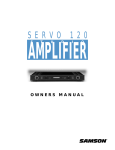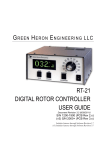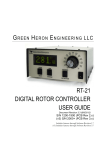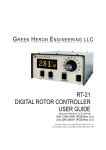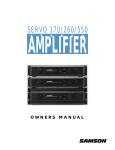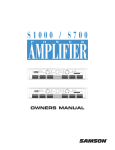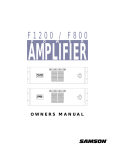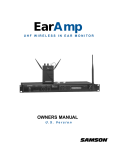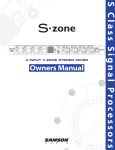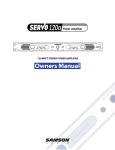Download Samson 4060/4120 Specifications
Transcript
SERVO 4060/4120 Q U A D AMPLIFIER OWNERS MANUAL ® Introduction 3 Servo Quad Amplifier Features 4 Guided Tour 5 Front Panel 5 Rear Panel 6 Setting Up and Using the Servo Quad Amplifier 7 The Servo Quad Amplifier Protection Circuitry 8 Bridge Stereo Mode 9 Bi-amplification Applications 10 Appendix A: Linearity vs. Frequency Sweep 11 Appendix B: Power Output vs. THD 12 Specifications 13 Introduction Congratulations on purchasing the Samson Servo Quad Amplifier! Although designed for easy operation, we suggest you first take some time to go through these pages so you can fully understand how we’ve implemented a number of unique features. The Servo Quad Amplifier is actually four discrete power amplifiers in a single chassis, optimized for use in live performance, recording studios, and permanent installations. This manual covers two Servo Quad Amplifier models, which differ primarily in terms of their power rating: the Servo 4060, which delivers 60 watts per channel into 4 ohms (or, in bridged mode, 120 watts into 8 ohms) and the Servo 4120, which delivers 120 watts of power per channel into 4 ohms (or, in bridged mode, 240 watts into 8 ohms). Both models operate over the full frequency spectrum (from 20 Hz to 50 kHz) and include dual bridging switches, four sets of binding post (banana jack) outputs, and both electronically balanced 1/4" TRS and unbalanced RCA-type input connectors Suggested applications for the Servo Quad Amplifier include: • Bi-amping applications - Because it is actually four amplifiers in one, the Samson Servo Quad Amplifier is particularly well-suited (in conjunction with appropriate crossover circuitry) to power small and medium size bi-amped speaker systems. • Amplification for main or nearfield monitors in both professional and project studios - Its superb audio specs and whisper-quiet performance (its convection cooling design means there is no fan) make the Servo Quad Amplifier the perfect complement to any recording studio. • Home Theatre applications - The sheer flexibility offered by the Servo Quad Amplifier (four discrete amplifier sections plus two independent bridging switches) makes it the perfect addition to any home theatre, in conjunction with any DVD player or other surround sound system. For example, use two channels to drive your front left/right speakers and the other two to drive your satellite rear speakers. Or use two channels for your front left/right speakers and bridge the remaining two channels to drive your center channel or subwoofer with power galore—you’re limited only by your imagination! • As an extension to a home hi-fi system - The Servo Quad Amplifier boasts professional specs which far exceed that of most consumer products. For a real “studio” experience in your own home, try connecting your home hi-fi amplifier’s auxiliary outputs to the Servo Quad Amplifier’s inputs (thus using your hi-fi amp as a preamplifier) and then connect your existing speakers to the Servo Quad Amplifier’s outputs. If you fall in love with the sound (as we’re sure you will), you might want to substitute a professional pre-amplifier for your existing hi-fi amp—and, from there, you may well end up graduating to higher-level speakers. High quality sound is addicting—don’t say we didn’t warn you! • Powering public address systems in permanent installations - The Servo Quad Amplifier can be used to effectively drive PA speakers in installations such as classrooms and corporate conference rooms. • Onstage monitoring - In small and medium-sized onstage areas (such as in clubs, lounges, etc.), the Servo Quad Amplifier can be used to drive stage monitors, allowing the performers to hear themselves without having to rely on onstage equipment amplification. • MIDI rack monitoring - MIDI musicians can easily incorporate the Servo Quad Amplifier into their existing rack of gear. Combined with a pair of high quality stage or studio monitors, this makes for an excellent monitoring system that can accurately reproduce the broad range of frequencies typically output by devices such as synthesizers, samplers, and digital audio workstations. In these pages, you’ll find a detailed description of the many features of the Servo Quad Amplifier, as well as a guided tour through its front and rear panels, step-by-step instructions for setting up and using your Servo Quad Power Amplifier, a description of suggested applications, reference appendices, and full specifications. You’ll also find a warranty card enclosed—please don’t forget to fill it out and mail it in so that you can receive online technical support and so we can send you updated information about these and other Samson products in the future. SPECIAL NOTE: Should your unit ever require servicing, a Return Authorization number (RA) is necessary. Without this number, the unit will not be accepted. Please call Samson at 1-800-372-6766 for a Return Authorization number prior to shipping your unit. Please retain the original packing materials and, if possible, return the unit in its original carton and packing materials. 3 Servo Quad Amplifier Features The Samson Servo Quad Amplifier utilizes the latest technology in professional power amplifier design. Here are some of its main features: • Power to spare - Each channel of the Servo 4060 delivers 60 watts into 4 ohms (or, in bridge stereo mode, 120 watts into 8 ohms). Each channel of the Servo 4120 delivers 120 watts of power into 4 ohms (or, in bridge stereo mode, 240 watts into 8 ohms). • Clean, crisp sound - Impressive audio specifications such as 0.05% THD, S/N of 95 dB, crosstalk of -70 dB, and frequency response of 20 Hz to 50 kHz guarantee ultra-clean sound quality in any live or recording environment. • Independent input controls for all four channels, with 41-position detents showing attenuation in dB. • Independent five-segment LED meters for each of the four channels continuously display power output levels and allow you to correct for overloading (clipping) conditions. • Front-panel Protection lights show you at a glance overheating or faulty wiring conditions. • Both electronically balanced 1/4" TRS and unbalanced RCA-type input connector jacks are provided. • Binding post (banana jack) output connectors. • Convection cooling (no fan) makes for whisper-quiet operation even in critical listening environments such as recording studios. • Unique bipolar circuit design that continuously keeps DC output during idling at or near 0 volts (thus keeping idle speakers at their 0 point). This serves to minimize heat overload problems by effectively preventing the Servo Quad Amplifier from applying power when unnecessary. • Protection relay circuitry (linked to the DC offset circuitry) that prevents “thumps” when powering on or off. This means that you can use the Servo Quad Amplifier with a single power strip into which a mixer or other audio devices are connected, without danger of damage to connected speakers. • Rugged construction (an all-steel chassis with a titanium finish and a lightweight anodized aluminum heat sink) makes the Servo Quad Amplifier eminently roadworthy. • Flexible design allows the Servo Quad Amplifier to be used free-standing or, with the use of included rack ears, mounted in any standard 19" rack (taking just two rack spaces). • Three-year warranty. • Last but certainly not least, value. The Samson Servo Quad Amplifier has been designed from the ground up to deliver excellent yet affordable sound quality. 4 Guided Tour - Front Panel 1 3 0 dB CLIP 70 100% -15 3 -16 -2 -27 -33 -40 4 -2 -27 -33 -40 4 LEVEL CHANNEL 3 -4 3 -2 -27 -33 -40 POWER 50 -19 -3 .5 4 CH3/4 PROTECTION SERVO 4120 - 120 WATT X 4 AMPLIFIER 30 -5 SAMSON 10 -9 0dB ∞ -0 .5 0dB ∞ 3 PROTECTION -20 dB -10 dB -3 dB 2 3 100% -3 CHANNEL 2 CLIP 70 -5 CHANNEL 1 0 dB -15 -9 -3 -3 -4 50 -16 -19 CH1/2 LEVEL 30 -1 -2 10 2 -27 -20 dB -10 dB -3 dB -1 -33 100% -5 -5 -40 CLIP 70 -9 -9 4 0 dB -15 2 2 -4 50 -16 -1 3 -19 -1 LEVEL 30 -4 10 3 -20 dB -10 dB -3 dB -0 100% ∞ CLIP 70 0dB 0 dB -15 .5 50 -16 -0 -19 ∞ 30 LEVEL 0dB 10 4 4 2 .5 -20 dB -10 dB -3 dB 5 5 -0 4 4 CHANNEL 4 3 1: Power switch - Use this to power the Servo Quad Amplifier on or off. 2: Power LED - Lit whenever the Servo Quad Amplifier is powered on. 3: Channel input controls (Ch 1 - 4) - These four 41-position knobs allow you to adjust the input level of the signal arriving at the rear-panel input jacks (see #4 and #5 on the following page). At their fully counterclockwise position (labeled “∞”), the signal is infinitely attenuated (completely off). At their fully clockwise position (labeled “0 dB”), the signal is at unity gain (that is, no attenuation). When 0 dBm of signal arrives at the input jacks and the Channel Input controls are set to their “0 dB” position, the Servo Quad Amplifier delivers full power output. 4: LED meters (Ch 1 - 4)- These five-segment LED meters continuously monitor the power output level for that channel. For convenience, the segments are labeled as follows, from left to right: -20 dB / 10%, -10 dB / 30%, -3 dB / 50%, 0 dB / 70%, and CLIP / 100%. When the left-most (-20 dB / 10%) segment is lit, the Servo Quad Amplifier is operating at 10% of its power capacity. When the right-most (CLIP / 100%) segment is lit, signal is being output at full strength. For the best signal-to-noise ratio, the right-most (CLIP / 100%) segment should light occasionally during peak levels; if it lights frequently, you may be overloading the Servo Quad Amplifier and a distorted (“clipped”) signal is probably being output. If this occurs and backing off the Input Level control delivers too low an output level for your application, consider using bridge stereo mode (see the “Bridge Stereo Mode” section on page 7 in this manual for more information). 5: Protection LEDs (Ch 1/2, Ch 3/4) - These go on for approximately five seconds whenever the Servo Quad Amplifier is powered on and fade slowly when the amp is powered off. When lit, 0 volts DC are provided to all connected speakers, thus muting them and preventing any “thump” from occurring. For a complete description of the conditions under which this light goes on, see the section entitled “The Servo Quad Amplifier Protection Circuitry” section on page 6 of this manual. 5 Guided Tour - Rear Panel 1 3 CAUTION RISK OF ELECTRIC SHOCK DO NOT OPEN + + 3 - - + + SERVO 4120 - QUAD AMPLIFIER ! USE CLASS 2 WIRING - emc + 4Ω 120W MAX. LOAD CH4 - EUR . USA . JPN + - AVIS; RISQUE DE CHOC ELECTRIQUE NE PAS OUVRIR DO NOT EXPOSE THIS EQUIPMENT TO RAIN OR MOISTURE. BRIDGE OFF AC INLET CH3 + MONO 8Ω ATTENTION: DISCONNECT SUPPLY CORD BEFORE CHANGING FUSE. FOR CONTINUED PROTECTION AGAINST RISK OF FIRE, REPLACE ONLY WITH SAME TYPE OF FUSE. DEBRANCHER AVANT DE REMPLACER LE FUSIBLE. UTILISERUN FUSIBLE DE RECHANGE DE MEM TYPE. ON FUSE CH4 R 6 4 CH3 R 5 - + 4Ω 120W MAX. LOAD + CH1 MONO 8Ω SAMSON SAMSON TECHNOLOGIES CORP., U.S.A. BRIDGE USA & CANADA T 8A/125V (115V) EUROPE AND UK T 6.3A/250V (230V) OFF CH2 L 4 2 + CH2 USA & CANADA 115V - 60Hz EUROPE & UK 230V - 50Hz 650W MAX. CAUTION: SERIAL NUMBER ON CH1 L 5 6 1: AC input - Connect the supplied standard 3-pin “IEC” plug here. 2: Fuse holder - In the Servo Quad 4060, insert an 6 amp, 125 volt fuse here for 115 volt operation, or a 3.15 amp, 250 volt fuse for 230 volt operation. In the Servo Quad 4120, insert an 8 amp, 125 volt fuse here for 115 volt operation, or a 6.3 amp, 250 volt fuse for 230 volt operation. We recommend the use of normal (as opposed to slow-blow) fuses. WARNING: Fuses should only be replaced with the power cord disconnected. 3: Binding post (banana jack) output connectors (Ch 1 - 4) - Use these to connect each channel of the Servo Quad Amplifier to loudspeakers. Be sure to connect the loudspeaker correctly, with the red (+) terminal normally connected to the positive input of the speaker and the black (-) terminal normally connected to the negative input of the speaker. See the “Bridge Stereo Mode” section on page 7 in this manual for speaker connection instructions when using the Servo Quad Amplifier in bridge mode. 4: Balanced Inputs* (Ch 1 - 4) - Connect incoming signal to these electronically balanced 1/4" TRS (Tip/Ring/Sleeve) jacks, wired as follows: Tip hot, Ring cold, and Sleeve ground. Use balanced threeconductor cabling and TRS plugs wherever possible (unbalanced two-conductor plugs can also be inserted into these inputs, but you’ll get better signal quality and less outside noise and hum if you use balanced lines). Note that the Servo Quad Amplifier balanced inputs are 6 dB higher in gain than the balanced inputs (see #5 below). The Servo Quad Amplifier accepts input levels of any strength but needs at least 0 dBm to get maximum power. 5: Unbalanced Inputs* (Ch 1 - 4) - Connect incoming signal to these unbalanced RCA-type jacks. The Servo Quad Amplifier accepts input levels of any strength but needs at least 0 dBm to achieve maximum power. Note that the Servo Quad Amplifier unbalanced inputs are 6 dB lower in gain than the balanced inputs (see #4 above). 6: Bridge switch - For normal operation, place this switch at its left (“OFF”) position. When placed at its right (“ON”) position, each of the two amplifier sections (channel 1 and channel 2 and/or channel 3 and channel 4) are bridged, providing full 120 or 240 watt power output, depending upon the Servo Quad model you’re using. For more information, see the “Bridge Stereo Mode” section on page 7 in this manual. WARNING: Due to the extremely high power output of the Servo Quad Amplifier when used in Bridge Stereo mode, be sure to use only 8 ohm loudspeakers sufficiently rated to handle the resultant wattage. * If required, both the balanced and unbalanced inputs can be used simultaneously. 6 Setting Up and Using the Servo Quad Amplifier Setting up your Servo Quad Amplifier is a simple procedure which takes only a few minutes: 1. Remove all packing materials (save them in case of need for future service) and decide where the amplifier is to be physically placed—it can be used free-standing or mounted in a standard 19" rack, requiring only two rack spaces. When installed, make sure that there is good ventilation around the entire unit (we recommend using spacer panels, especially if multiple amplifiers are used in a rack. Before rack-mounting, use a Philips screwdriver to attach the included rack ears. BRIDGE OFF 2. Set either or both rear panel Bridge switches as desired (see page 7 in this manual for more information). ON Bridge on/off switch - + - + + 4Ω 120W MAX. LOAD CH2 - + CH1 + MONO 8Ω Speaker connectors CH2 L CH1 L Input connectors IEC connector CH3/4 POWER 3. Make the speaker connections, using the binding post (banana plug) output connectors on the rear panel. It is never a good idea to power up any amplifier that is not connected to loudspeakers. In normal modes of operation, any loudspeakers with a minimum impedance load of 4 ohms (that is, 4 ohms or greater) can be used; however, in Bridge Stereo mode, 8 ohm speakers must be used. Be sure to connect the loudspeaker correctly. In normal mode, connect them with the red (+) terminal connected to the positive input of the speaker and the black (-) terminal connected to the negative input of the speaker. Refer to page 7 in this manual for connection instructions when using the Servo Quad Amplifier in Bridge Stereo mode. If you are using the Servo Quad Amplifier for bi-amping applications, refer to the “Bi-amplification Applications” section on page 8 in this manual for more information. 4. Next, make the signal input connections, using the electronically balanced 1/4" and/or the unbalanced RCA-type input connectors on the rear panel. If your mixer or crossover network has balanced outputs, use the Servo Quad Amplifier’s electronically balanced inputs (unbalanced two-conductor plugs can also be inserted into these inputs, but you’ll get better signal quality and less outside noise and hum if you use balanced lines). If you are using the Servo Quad Amplifier for bi-amping applications, refer to the “Bi-amplification Applications” section on page 8 in this manual. 5. On the front panel of the Servo Quad Amplifier, turn all four Channel input controls fully counterclockwise (to their “∞” setting). Then connect the supplied 3-pin “IEC” cable to the rear panel IEC connector and to any grounded AC socket. Because of the relay protection circuitry built into the Servo Quad Amplifier, you can even plug it into the same power strip that other audio devices (such as a mixing console) are connected to. You can then turn on all devices at once with the single power strip onoff switch, with no danger of damaging connected speakers by generating “thumps.” 6. Press the front panel Power switch in order to turn on the Servo Amplifier. The Power LED will light and the two Protection LEDs will go on for approximately five seconds, and then switch off (you’ll hear a click when they do so). PROTECTION Power switch and Protection LED 7. Apply an input signal to the amplifier at or about 0 dbM (if sending signal from a mixer, drive the output meters at approximately 0 vu). While the input signal is present, slowly raise the Channel input controls until the desired sound level is achieved. The five-segment LED meters above each Channel input control will show you the continuous power output of the Servo Quad Amplifier as signal is being passed. For the best signal-to-noise ratio, the Servo Quad Amplifier should normally be run with the Channel input controls at or near maximum (fully clockwise, at the “0 dB” position) and the right-most (CLIP / 100%) segment should light occasionally (but not frequently) during peak levels. If you are using a mixing board that has a master output level control (sometimes called “control room level”), use it to attenuate the signal as necessary to achieve the desired speaker level. If you encounter difficulty with any aspect of setting up or using your Servo Quad Amplifier, you can call Samson Technical Support (1-800-372-6766) between 9 AM and 5 PM EST. 7 The Servo Quad Amplifier Protection Circuitry As noted in the “Guided Tour” section of this manual, the Servo Amplifier's front panel Protection lights indicate the activity of the relay speaker connection circuitry. When the Protection lights are lit, this circuitry is inactive, and all connected speakers are muted (provided with 0 volts DC), thus protecting them and preventing any audible “thump” from occurring. The following conditions will cause the Protection lights to go on: • Initial power-up: For approximately five seconds after initial power-up, the relay speaker connection circuitry is deactivated and the speaker output is muted. If everything is operating normally, you will hear an audible click at the conclusion of this brief period, as the circuitry is activated and the Servo Quad Amplifier begins delivering signal to connected speakers. It is normal for the Protection light to fade gradually after the amplifier is powered off. WARNING: If a Protection light fails to go out (and you fail to hear the accompanying audible click) approximately five seconds after power-up, turn the Servo Quad Amplifier off immediately and check all external devices and wiring for possible shorts or other defects. • Overheating: A temperature sensing device in the Servo Quad Amplifier will cause the relay speaker connection circuitry to be deactivated (and the Protection light to go on) whenever the operating temperature of the unit rises above a safe level. To guard against this problem, make sure the Servo Quad Amplifier receives adequate ventilation on all sides (see page 5 for more information); in extreme environmental conditions, you may also want to consider the use of cooling fans. • Severe overcurrent conditions: This occurs whenever the signal being input to the Servo Quad Amplifier rises to a level above 20% THD (Total Harmonic Distortion). • Shorted speaker cables: This will occur if, due to faulty wiring, the hot and ground signals being output by the Servo Quad Amplifier short one another. • Output impedance drops below 2 ohms: This can occur if the Servo Quad Amplifier is connected to inappropriate speaker systems (see the “Setting Up and Using the Servo Quad Amplifier” section on page 5 in this manual for more information). • DC voltage detected at speaker output: The most likely cause of this is an internal failure. In general, any time either or both of the Protection lights go on (other than during the approximately five seconds following initial power-up), there is reason to be concerned. If this occurs, turn the Servo Quad Amplifier off immediately and carefully check all wiring and external devices in order to locate and correct the condition that caused the light to go on in the first place. 8 CH3/4 PROTECTION Bridge Stereo Mode BRIDGE OFF ON The Servo Quad Amplifier provides two rear-panel switches that allow it to be used in a unique bridge stereo mode. When these switches are in their “Off” (left) position, the Servo Quad Amplifier functions as a true quad amplifier, where each of the four independent amplifier channels can receive different input signal and produce independent output signal. However, when either switch is placed in the “On” (right) position, the pair of amplifier channels (1/2 or 3/4) process only the signal present at one input, thus producing a monophonic output signal with a true 120 watt (in the case of the Servo Quad 4060 model) or 240 watt (in the case of the Servo Quad 4120 model) output into 8 ohms. When both Bridge switches are placed in the “On” position, the Servo Quad amplifier operates in bridge stereo mode, acting like a true stereo amplifier, delivering 120 watts of power per channel (in the case of the Servo Quad 4060 model) or 240 watts of power per channel (in the case of the Servo Quad 4120 model). WARNING: Bridge stereo mode is to be used only when the Servo Quad Amplifier is connected to an 8 ohm speaker load. Use of bridge stereo mode with speaker loads of 4 ohms or less can result in severe damage to the Servo Quad Amplifier due to excessive heat and current limiting and will void your warranty! INPUT (CHANNEL 2) CHANNEL 2 (+) OUTPUT CHANNEL 1 (+) OUTPUT The illustration on the left shows how this works. In bridge stereo mode, the polarity (phase) of the channel 1 output signal is reversed relative to that of the channel 2 output signal (similarly, the channel 4 output signal is reversed relative to that of channel 3). Channels 1 and 2 then process the signal being input to channel 2 (and channels 3 and 4 process the signal being input to channel 3), but the speaker load is connected so that power is derived from both channels. The effective voltage swing seen by the load is thus doubled so that the power output is doubled. When using the Servo Quad Amplifier in bridge stereo mode, be sure to connect each loudspeaker as shown in the illustration below (and as silkscreened on the rear panel), with the red (+) terminal of channel 2 (and/or channel 3) connected to the positive input of the speaker and the red (+) terminal of channel 1 (and/or channel 4) connected to the negative input of the speaker. Do not use the black (-) output terminal of either channel (the speaker load must “float” away from the amplifier chassis). CAUTION RISK OF ELECTRIC SHOCK DO NOT OPEN + + - + + - SERVO 4120 QUAD AMPLIFIER - + 4Ω 120W MAX. LOAD CH4 emc + - CH3 AC INLET + MONO 8Ω EUR . USA . JPN AVIS; RISQUE DE CHOC ELECTRIQUE NE PAS OUVRIR DO NOT EXPOSE THIS EQUIPMENT TO RAIN OR MOISTURE. - ! USE CLASS 2 WIRING BRIDGE OFF CAUTION: ATTENTION: DISCONNECT SUPPLY CORD BEFORE CHANGING FUSE. FOR CONTINUED PROTECTION AGAINST RISK OF FIRE, REPLACE ONLY WITH SAME TYPE OF FUSE. DEBRANCHER AVANT DE REMPLACER LE FUSIBLE. UTILISERUN FUSIBLE DE RECHANGE DE MEM TYPE. ON FUSE CH4 R CH3 R + - 9 USA & CANADA 115V - 60Hz EUROPE & UK 230V - 50Hz 650W MAX. USA & CANADA T 8A/125V (115V) EUROPE AND UK T 6.3A/250V (230V) + CH2 4Ω 120W MAX. LOAD + + - SERIAL NUMBER CH1 SAMSON MONO 8Ω SAMSON TECHNOLOGIES CORP., U.S.A. BRIDGE OFF CH2 L CH1 L ON Bi-amplification Applications Because the Samson Servo Quad Amplifier actually contains four discrete power amplifiers in a single chassis, it is particularly well-suited for use with bi-amped speaker systems. These systems utilize active crossover networks (sometimes called electronic crossovers) that are specially designed to handle low-wattage line-level signals. As shown in the illustration on the right, the crossover in such a system is placed just prior to the power amplifier in the signal chain. The circuitry in a two-way active crossover network divides the incoming signal into its high and low frequency components. Those frequencies above a specified crossover point are sent to one discrete output and those below the crossover point are sent to the other. Each output is then connected to a separate power amplifier channel input. In this way, one amplifier powers the loudspeaker’s low frequency drivers (“woofers”) and another powers the loudspeaker’s high frequency drivers (“tweeters”). The advantage to bi-amping is not only enhanced loudspeaker performance (since each speaker driver is receiving optimized signal) but also greatly reduced distortion. This is because most of the energy in musical signals lies in its low frequency components (next time you’re listening to a piece of popular music, contrast the level of kick drum and bass guitar to the other instruments). When both low and high frequencies are present in a signal, these high-energy low frequency signals can eat up all the available headroom in a power amplifier, leaving none for the higher frequencies. The end result is nasty clipping distortion of the high frequency material. The use of an active crossover network effectively eliminates this problem—in fact, you’ll get cleaner, perceptively louder signal than if you were to use a single higher-power amplifier instead! Of course, with four amplifiers at your disposal, you can use your Samson Servo Quad Amplifier to bi-amp both the left and right signals in a stereo system. Simply use a stereo active crossover network and route the two left outputs (low and high frequency) to the Servo Quad Amp channel inputs 1 and 2 and the two right outputs to channel inputs 3 and 4. You can then use the front-panel input level controls to adjust the relative levels of each output signal. 10 LEFT INPUT SIGNAL RIGHT INPUT SIGNAL ACTIVE CROSSOVER NETWORK LEFT LF HF OUT OUT RIGHT LF HF OUT OUT CH1 CH2 IN IN CH3 CH4 IN IN SERVO QUAD AMPLIFIER CH1 CH2 OUT OUT LEFT WOOFER INPUT CH3 CH4 OUT OUT LEFT RIGHT TWEETER WOOFER INPUT INPUT RIGHT TWEETER INPUT Appendix A: Linearity vs. Frequency Sweep AUDIO PRECISION servo 4060/4120 THD +N (%) & LEVEL (W) vs FREQ (Hz) 0dB ref THD 1.000 5.0000 Ap .9000 4.0000 3.0000 .8000 2.0000 .7000 1.0000 .6000 0.0 .5000 -1.000 .4000 -2.000 .3000 -3.000 .2000 -4.000 .1000 0.0 -5.000 10 100 1k 10k Linearity (0 dB Ref) vs. frequency sweep 20 Hz - 50 kHz 11 50k Appendix B: Power Output vs. THD AUDIO PRECISION servo 4060/4120 THD +N (%) & LEVEL (W) vs FREQ (Hz) THD Watts .50000 80.000 / 160.000 Ap .45000 73.333 / 146.666 66.667 / 133.333 .40000 60.000 / 120.000 .35000 53.333 / 106.666 .30000 46.667 / 93.333 .25000 40.000 / 80.000 33.333 / 66.666 .20000 26.667 / 53.333 .15000 20.000 / 40.000 .10000 13.333 / 26.666 .05000 6.666 / 13.333 0.0 0.000 / 0.000 10 1k 100 10k 20k Power output (Servo 4060 @ 60 W, Servo 4120 @ 120 W) vs. Total Harmonic Distortion 12 Specifications 1. Rated Output Power, per channel At 1 kHz, 4 ohm, .<0.05% THD+N Model 4120 Model 4060 At 1 kHz, 4 ohm, 1% THD+N Model 4120 Model 4060 At 1 kHz, 8 ohm, <0.05% THD+N Model 4120 Model 4060 At 1 kHz, 8 ohm, 1% THD+N Model 4120 Model 4060 120 W 60 W 150 W 80 W 120 W 60 W 130W 64 W 2. Typical Distortion, per channel THD+N (80 kHz LPF @ 1 kHz, rated output power) IMD (SMPTE 4:1, 60 Hz & 7 kHz @ rated output power) .005% .015% 3. Signal To Noise Ratio (22 Hz - 22 kHz bandwidth @ dB below rated output power) 95 dB 4. Frequency Response 5. Input Sensitivity 6. Crosstalk (adjacent channels) 20 Hz - 50 kHz, 0 - 3 dB +4 dBu to achieve rated power (Level control set to maximum) -70 dB, 1 kHz 7. Output DC Offset Voltage 0 ± 50 mV, DC Servo Controlled 8. Dimensions (without rack ears) 17.5 in (w) x 10.75 (d) x 3.25 (h) 444 mm (w) x 273 (d) x 82.5 (h) 9. Weight Model 4120 Model 4060 29.5 lbs • 13.4 kg 25 lbs • 11.3 kg 13 Produced by On The Right Wavelength for Samson Technologies Corp. Copyright 1997, Samson Technologies Corp. Printed April, 1997 Samson Technologies Corp. 575 Underhill Blvd. P.O. Box 9031 Syosset, NY 11791-9031 Phone: 1-800-3-SAMSON (1-800-372-6766) Fax: 516-364-3888














